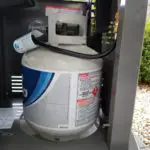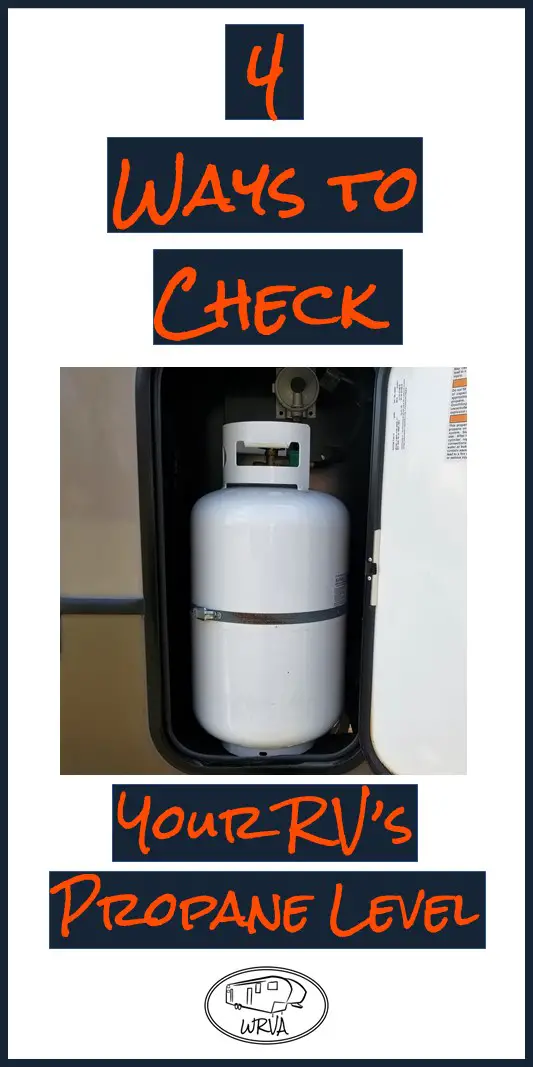Best RV Propane (LPG) Tank Monitor (Level Sensor)
I woke up freezing cold during a late fall camping trip, do you know why? I ran out of propane and that caused my furnace to stop. The inability to monitor your RV’s propane level can leave you without gas, just when you need it most.
Don’t let this happen to you too.
RVs come with all kinds of monitors and sensors. Fresh water and sewage tank levels, smoke detectors, carbon monoxide sensors, battery monitors. Unfortunately, one thing is missing on most RVs, a propane tank monitor.
If you aren’t lucky enough to have a rig with a factory propane monitor this process probably sounds familiar to you:
- Remove your tank cover (or open the storage bay)
- Disconnect the line to the tank’s valve
- Un-hook the bracket or tank clamp
- Lift the tank and guess how full it is
If you have done this a few times you know its’ not much fun, and unless you know the empty weight of your tank and can set it on a scale. You are still just guessing at exactly how much propane is left.
Think for a minute about everything in your camper that runs on propane.
- Furnace
- Water Heater
- Refrigerator
- Stove
- Oven
- Outdoor Range or Grill
Being able to monitor the level of your RV’s propane tanks quickly and easily is a great way to avoid being stuck, unable to use any of those appliances.
So, how can you tell how much propane is left in the tank?
If your RV didn’t come with a level sensor and monitor from the factory there are a few great options out there.
Option 1: See-through (translucent) propane cylinders
One option is to swap out your steel propane cylinder for a composite model that allows you to see the level of the propane. Viking is large manufacturer of composite propane cylinders.
Click here to see the Viking 17lb cylinder reviews on Amazon
Pros of composite propane tanks
- Can see propane level
- Lighter weight
- Won’t rust
Cons of composite propane cylinders
- Dimensions may not match steel
- May be difficult to have re-certified
Option 2: Propane level sensors
Before looking at the sensors on the market let’s take a quick look at the ways you can check the level in a propane cylinder and what the advantages of each are.
Types of propane level sensors
If you would rather stay with a traditional steel propane tank there are 4 common types of propane level sensors available.
- Ultrasonic Sensors
- Pressures Sensors
- Temperature Sensors
- Weight Sensors
You probably already know that propane tanks are sized by weight not volume. Common RV sizes are 20, 30 and 40 lbs. This is not the weight of the tank, it is the weight of propane the tank can hold. If you have ever taken a tank to be filled, you probably noticed that the tank is filled on a scale to measure the weight of propane being added. This makes weight one of the most accurate ways to check your tank as well.
Ultrasonic propane level sensors
Ultrasonic level sensors measure the actual level of the liquid propane in the cylinder. They are placed on the bottom of the tank and emit a high frequency sound. The level in the tank is calculated by measuring the time for the sound wave to reflect off the surface of the liquid propane. Check out this Wikipedia page for more information on how ultrasonic sensors work.
Ultrasonic sensors can be monitored by a remote display or using an app on your smart phone. This makes them ideal for RVs.
Propane tank pressure sensors
As propane is used up the pressure in the tank will decrease. You can install a gauge between your tank and regulator that will measure the tank pressure. This type of sensor doesn’t give an exact measurement, because the tank pressure can be affected by other things like temperature.
Pressure gauges will usually have 3 readings
- Good
- Low
- Empty
There are 2 downsides to this type of sensor. First, when it reads low, you don’t know for sure when you will run out. Second, then cannot be remotely checked. You have to be at the tank to see the level.
Propane tank temperature level sensors
Propane is stored as a liquid in the tank. When propane is used it boils and comes out of the tank as a gas. This process takes heat away from the metal tank cooling it down. You can read more about how that happens here. This is why you might have noticed while grilling burgers that the bottom half of your tank is covered in sweat or frost, while the top half is still dry.
Magnetic indicators are available that show where the temperate shift is at by changing color. These indicators are usually only a couple inches tall so if you want to cover the whole tank you will need more than one. They are around $10 so even if you purchase 4 of them for 2 tanks you aren’t out too much money.
Like the pressure gauge these have a few downsides. They only work when you are using propane, because if the liquid isn’t converting to a gas there won’t be a temperature change. Like the pressure gauge this indicator cannot be remotely checked.
Propane tank weight sensors

Weight is a very accurate way to measure the level in a propane tank. You can buy scales designed to set your tank on. You can also find spring loaded scales the tank hangs from. The problem with this type of measurement is RV propane tanks need to be securely held in place when you are traveling down the road. So, while weight sensors are the best choice for your back-yard grill, they don’t work well for your RV unless you plan to take them off before you travel.
If your RV is parked in a seasonal site where it won’t be moving and you can unstrap your tanks this is an option. Just remember to secure the tanks before you move again.
Propane level indicator comparison
Below are my 4 favorite propane level indicators. I have chosen 1 model of each type for this comparison.
Top Pick – AP Products (Mopeka) LPG TankCheck Ultrasonic LP Sensor
The Tank Check system is a battery powered sensor that attaches with built-in magnets to the bottom of your RV’s propane cylinder(s). The Sensor is compatible with 20, 30, and 40 lb vertical propane tanks. It can also be used on horizontal tanks up to 30 inches in diameter. Tanks must be steel to allow the magnets to stick.
Click here to check pricing for the Tank Check System on Amazon
How do you check the tank level?
You can monitor the level of your tanks in 2 ways, via a smartphone app or with the standalone monitor. Sensors can be paired with the app and the monitor at the same time, this allows the best of both options.
Tank check app
The tank check app is free and available for Android and iOS. The app allows you to add as many sensors as you would like. You could have 2 sensors on your RV, but you could also have one on your backyard grill or any other propane powered device.
When using the app you can setup alarms to notify you when a tank gets low.
Tank Check stand-alone monitor
The included stand-alone wireless monitor can be installed permanently in your RV and can be checked just like your water and battery monitors. For a less permanent installation some adhesive Velcro strips could be used to mount the monitor.
The stand-alone monitor can be paired with 2 tank sensors. The propane level is displayed with 5 LEDs for each tank. Pressing the tank 1 or 2 button displays the level of the corresponding tank.
How long do the tank check batteries last?
The sensor and monitor are powered by a CR2032 watch style battery (don’t worry, they come with the system). The Sensor battery life is about 1 year, the monitor should last even longer depending on how often you check the level. If you replace the batteries each spring when you get ready for the camping season you shouldn’t have any problems.
LPG TankCheck battery replacement video
Additional Sensors
Additional sensors are available, but only 2 can be paired to the monitor. If you need to replace a sensor you can pair the replacement with your original monitor panel.
Click here to see the sensors on Amazon
Tank Check System Specifications
| Number of Sensors Included | 2 |
| Max Number of Propane Tanks Monitored | 2 w/monitor panel, unlimited with app |
| Compatible Tank Sizes | 20, 30 and 40 lb vertical, up to 30” diameter Horizontal |
| Battery Life | About 1 year |
| Sensor Range | About 100 ft |
| Type of communication | Bluetooth |
| Warranty | 3 Year |
Troubleshooting and User Impressions
- Spacers are included to make sure the weight of the tank doesn’t sit on the sensor. These were made of rubber and didn’t hold up. They are now aluminum and are more durable. If you have the old style you can Contact Mopeka to get the new version.
- The tank must be stationary to get an accurate reading. If the propane is sloshing around in the tank the level will not be accurate.
- Users have verified the sensors work down to -22 degrees F, but the batteries will not last long at very low temperatures.
- Placing the sensor off center can cause bad readings. The sensor has to be pointed straight up for the ultrasonic waves to properly reflect back off the surface of the liquid propane to the sensor.
Value Pick – Camco Propane Gauge/Leak Detector (Pressure Gauge)
If you just want to know when your tank is getting low the Camco Gauge is a great choice.
Check the Camco Propane Gauge price on Amazon
How the Camco Gauge works
This gauge is more of a warning indicator than a level gauge. Because pressurized propane is stored in liquid form the pressure in the tank doesn’t begin to noticeably drop off until the liquid is nearly gone. That means this gauge will stay in the green for a while. Then it will move quickly through the yellow and then red ranges indicating the tank needs to be refilled.
To check the gauge you have to look at it, there aren’t any fancy alarms or notifications. When the gauge is in the green there isn’t much to worry about, but once it gets into the yellow range you should check it more often to make sure you don’t run out of LP gas.
Why is it better than other pressure style propane gauges?
Most gauges have a dial with a single scale the Camco gage has 3 scales, hot, cool and cold. The outside temperature can affect the pressure in the tank so this eliminates the guesswork when the temperature is extremely hot or cold.
Other Options
I am including these options because in some cases you may want to use them, but for most people, I recommend choosing one of the previous models.
Original Grill Gauge
To check your tank just place the hook through the top of the tank then lift up the cylinder. The pointer will show how full your tank is. This sounds simple, but in most RVs lifting the tank requires several minutes of removing covers and unhooking clamps.
Another downside of this scale is that it is only designed for 15 and 20 lb tanks. If your RV has a larger 30 or 40 pound tank you can still use it. You would have mark the gauge after lifting an empty tank, because the larger tank will not read empty on this gauge.
Check the current Grill Gauge price on Amazon
GasWatch TVL214 Digital Tank Scale
Like the Grill Gauge this scale measures the level of propane by weighing the tank. This time it uses a digital scale that the tank sits on. If your RV is parked in a seasonal site this could be a good option for you. If you travel a lot I wouldn’t suggest trying this model, it isn’t designed for bouncing of the tank while driving so it would just be one more thing to do every time you set up camp.
Check price and reviews for the GasWatch on Amazon
GrillPro 00030 Magnetic Gas Level Indicator (temperature sensor)
This gauge sticks directly to the side of your tank and measures the level by sensing the change in temperature between the liquid and gas inside. Like I mentioned before this type of sensor only works when gas is flowing. In some cases even if the gas is being used, but at a very low rate there will not be enough of a temperature shift to measure the level.
2 of these indicators would be needed if you want to cover the full range of most tanks. If you are only concerned with when the tank is getting close to empty you could just place one indicator near the bottom. Or you could reposition the indicator as the level decreases.
This is without a doubt the lowest cost option, so if you want to give it a try, you wouldn’t be out much cash if you aren’t happy with it.
There are several reviews on Amazon stating that this indicator does not work. I am guessing that they didn’t understand the principle behind this gauge. If you are running a grill or stove for awhile this gauge should work just fine.
Click here to check pricing and reviews for the GrillPro on Amazon
Wrap-Up
If you still haven’t decided which propane tank monitor to choose for your RV let me suggest you give the TankCheck System a try. For around $100 it isn’t going to break the bank, but it will provide the most convenient way to monitor the level in your RV’s propane tank. It is also the only model I reviewed that comes with everything you need to monitor 2 tanks.
If you have any of these products please leave a comment below with what you like or don’t like about it.
Finally, if you found this helpful I would really appreciate it if you share this on Pinterest using the image below.

Click here for some more of my favorite RV Tips
Thanks for reading,
Jason







Thanks for sharing.Amazing content
I had an app in my previous phone where I held the phone next to my tank, hit a button, and a tone emitted which then displayed the gas level in my tank. I can’t find it anywhere now. What gives?
Ernest,
I’ve never heard of that app, but if you find it please let me know.
I would love to try it myself.
Thanks,
Jason
I got Rochester gauge brand new and still showing inside the motorhome full and on Propane tank showing half
what I should do to fix it? I already replace the gauge clip on it whit 2 small wire come out of it,
connect properly whit the existent wire.
Please back to me
Denis
Denos,
I don’t have any experience with the Rochester gauge. It does sound like a wiring or electronics problem. Maybe someone else will have some advice for you.
Thanks,
Jason
I used the Camco Propane Gauge Leak Detector to connect to my RV propane tank so I wouldn’t be surprised next time it runs out. Works exactly as you would expect. No complaints. Just keep in mind that once it starts moving to the yellow, RUN, do not walk to the refill station. This does not work like a gas tank: it works by pressure: so once it starts to drop that low it is a lot closer to empty than you would think.
Thanks for the information.
Jason
I just discovered that U-Haul sells empty 20 lb propane tanks with float gauges. Of course you’ll want to refill them, not exchange, but it’s got to be a more accurate level gauge than the temperature measurement or ultrasonic gauges, and it’s virtually free since the price is about the same as any empty tank.
Thanks, I had no idea they did that. Do you remember if they had larger tanks or was it just the 20lb size?
Jason
I never know how much gas is left in the propane tanks and the last thing I want to do is run out in the middle of canning something. GASLAND is a great tool to determine when it’s time to switch the tank. It isn’t an exact measure but it gives you a general idea of whether there is enough left for the task at hand.
Previously, I always worry because I don’t know when I will run out of propane. It was too inconvenient so I bought Dozyant. Luckily it installs easily, just screws it on between the tank and the supply hose
The Camco propane tank gauge replacement is compatible with older propane inlet valves used in RVs, vessels, and propane gas grills. This is what I use on my ten-year-old RV to allow me to use modern tanks, and it works perfectly as a converter.